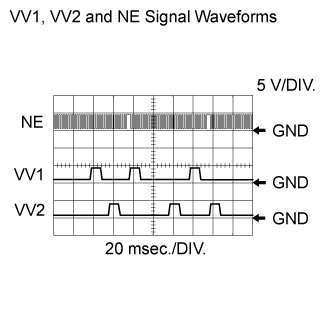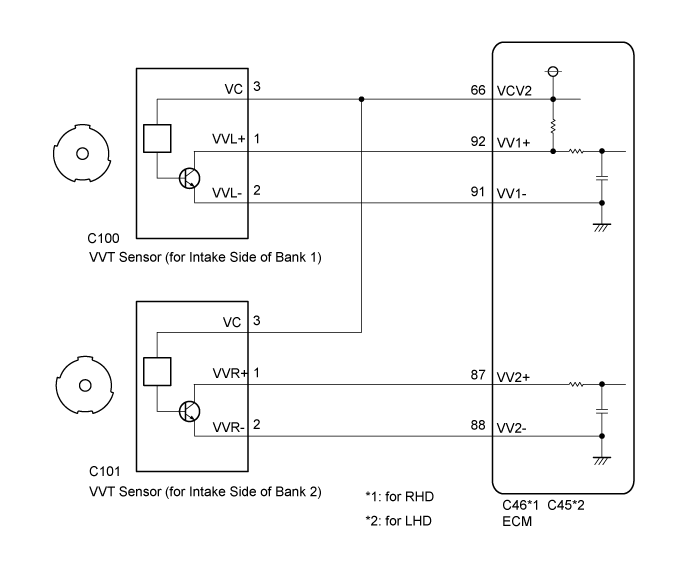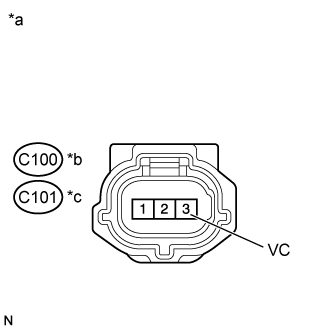Dtc P0340 Camshaft Position Sensor Circuit Malfunction
DESCRIPTION
MONITOR DESCRIPTION
CONFIRMATION DRIVING PATTERN
WIRING DIAGRAM
INSPECTION PROCEDURE
CHECK HARNESS AND CONNECTOR (SENSOR POWER SOURCE)
CHECK HARNESS AND CONNECTOR (VVT SENSOR FOR INTAKE CAMSHAFT - ECM)
CHECK SENSOR INSTALLATION (VVT SENSOR FOR INTAKE CAMSHAFT)
INSPECT INTAKE CAMSHAFT (TEETH)
REPLACE VVT SENSOR
CHECK WHETHER DTC OUTPUT RECURS
DTC P0340 Camshaft Position Sensor Circuit Malfunction |
DTC P0342 Camshaft Position Sensor "A" Circuit Low Input (Bank 1 or Single Sensor) |
DTC P0343 Camshaft Position Sensor "A" Circuit High Input (Bank 1 or Single Sensor) |
DTC P0345 Camshaft Position Sensor "A" Circuit (Bank 2) |
DTC P0347 Camshaft Position Sensor "A" Circuit Low Input (Bank 2) |
DTC P0348 Camshaft Position Sensor "A" Circuit High Input (Bank 2) |
DESCRIPTION
The intake camshaft VVT sensor (VV1 and VV2 signal) consists of a magnet and MRE (Magnetoresistive Element).The intake camshaft has 3 teeth on its outer circumference. When the intake camshaft rotates, changes occur in the air gaps between the 3 teeth and MRE, which affects the magnetic field. As a result, the resistance of the MRE fluctuates. The VVT sensor converts the camshaft rotation data into pulse signals, uses the pulse signals to determine the camshaft angle, and sends the data to the ECM.The crankshaft angle sensor rotor has 34 teeth. The MRE generates 34 signals for each crankshaft revolution. Based on a combination of the VVT signal and NE signal, the ECM detects the crankshaft angle. Then the ECM uses this data to control fuel injection time and injection timing. Also, based on the NE signal, the ECM detects the engine speed.DTC No.
| DTC Detection Condition
| Trouble Area
|
P0340
P0345
| No VVT sensor signal is sent to the ECM at an engine speed of 600 rpm or more (1 trip detection logic).
| - Open or short in VVT sensor circuit for intake camshaft
- VVT sensor for intake camshaft
- Intake camshaft
- Timing chain for intake camshaft jumped tooth
- ECM
|
P0342
P0347
| Output voltage of VVT sensor is below 0.3 V for 4 seconds (1 trip detection logic).
| - Open or short in VVT sensor circuit for intake camshaft
- VVT sensor for intake camshaft
- Intake camshaft
- Timing chain for intake camshaft jumped tooth
- ECM
|
P0343
P0348
| Output voltage of VVT sensor is higher than 4.7 V for 4 seconds (1 trip detection logic).
| - Open or short in VVT sensor circuit for intake camshaft
- VVT sensor for intake camshaft
- Intake camshaft
- Timing chain for intake camshaft jumped tooth
- ECM
|
- Reference: Inspection using an oscilloscope
- Standard:
for RHDTester Connection
| Tool Setting
| Condition
| Specified Condition
|
C46-110 (NE+) - C46-111 (NE-)
| 5 V/DIV.
20 msec./DIV.
| Cranking or idling
| The correct waveform is as shown
|
C46-92 (VV1+) - C46-91 (VV1-)
| 5 V/DIV.
20 msec./DIV.
| Cranking or idling
| The correct waveform is as shown
|
C46-87 (VV2+) - C46-88 (VV2-)
| 5 V/DIV.
20 msec./DIV.
| Cranking or idling
| The correct waveform is as shown
|
for LHDTester Connection
| Tool Setting
| Condition
| Specified Condition
|
C45-110 (NE+) - C45-111 (NE-)
| 5 V/DIV.
20 msec./DIV.
| Cranking or idling
| The correct waveform is as shown
|
C45-92 (VV1+) - C45-91 (VV1-)
| 5 V/DIV.
20 msec./DIV.
| Cranking or idling
| The correct waveform is as shown
|
C45-87 (VV2+) - C45-88 (VV2-)
| 5 V/DIV.
20 msec./DIV.
| Cranking or idling
| The correct waveform is as shown
|
- HINT:
- VV1 and VV2 are the VVT sensor signals, and NE is the crankshaft position sensor signal.
MONITOR DESCRIPTION
If no signal is transmitted by the VVT sensor despite the engine running, or the rotations of the camshaft and crankshaft are not synchronized, the ECM interprets this as a malfunction of the sensor.Also, when the sensor output voltage remains at below 0.3 V, or higher than 4.7 V for more than 4 seconds, the ECM stores a DTC.
CONFIRMATION DRIVING PATTERN
- Start the engine and run it at idle for 10 seconds or more.
WIRING DIAGRAM
INSPECTION PROCEDURE
- HINT:
- Read freeze frame data using the GTS. Freeze frame data records the engine conditions when malfunctions are detected. When troubleshooting, freeze frame data can help determine if the vehicle was moving or stationary, if the engine was warmed up or not, if the air-fuel ratio was lean or rich, and other data from the time the malfunction occurred.
- Bank 1 refers to the bank that includes the No. 1 cylinder*.
*: The No. 1 cylinder is the cylinder which is farthest from the transmission.
- Bank 2 refers to the bank that does not include the No. 1 cylinder.
| 1.CHECK HARNESS AND CONNECTOR (SENSOR POWER SOURCE) |
Disconnect the VVT sensor connector.
Measure the voltage according to the value(s) in the table below.
- Standard Voltage:
Tester Connection
| Switch Condition
| Specified Condition
|
3 (VC) - Body ground
| Engine switch on (IG)
| 4.5 to 5.0 V
|
Text in Illustration*a
| Front view of wire harness connector
(to VVT Sensor)
|
*b
| Bank 1
|
*c
| Bank 2
|
| | REPAIR OR REPLACE HARNESS OR CONNECTOR |
|
|
| 2.CHECK HARNESS AND CONNECTOR (VVT SENSOR FOR INTAKE CAMSHAFT - ECM) |
Disconnect the VVT sensor connector.
Disconnect the ECM connector.
Measure the resistance according to the value(s) in the table below.
- Standard Resistance:
for RHDTester Connection
| Condition
| Specified Condition
|
C100-1 (VVL+) - C46-92 (VV1+)
| Always
| Below 1 Ω
|
C100-2 (VVL-) - C46-91 (VV1-)
| Always
| Below 1 Ω
|
C101-1 (VVR+) - C46-87 (VV2+)
| Always
| Below 1 Ω
|
C101-2 (VVR-) - C46-88 (VV2-)
| Always
| Below 1 Ω
|
C100-1 (VVL+) or C46-92 (VV1+) - Body ground
| Always
| 10 kΩ or higher
|
C100-2 (VVL-) or C46-91 (VV1-) - Body ground
| Always
| 10 kΩ or higher
|
C101-1 (VVR+) or C46-87 (VV2+) - Body ground
| Always
| 10 kΩ or higher
|
C101-2 (VVR-) or C46-88 (VV2-) - Body ground
| Always
| 10 kΩ or higher
|
for LHDTester Connection
| Condition
| Specified Condition
|
C100-1 (VVL+) - C45-92 (VV1+)
| Always
| Below 1 Ω
|
C100-2 (VVL-) - C45-91 (VV1-)
| Always
| Below 1 Ω
|
C101-1 (VVR+) - C45-87 (VV2+)
| Always
| Below 1 Ω
|
C101-2 (VVR-) - C45-88 (VV2-)
| Always
| Below 1 Ω
|
C100-1 (VVL+) or C45-92 (VV1+) - Body ground
| Always
| 10 kΩ or higher
|
C100-2 (VVL-) or C45-91 (VV1-) - Body ground
| Always
| 10 kΩ or higher
|
C101-1 (VVR+) or C45-87 (VV2+) - Body ground
| Always
| 10 kΩ or higher
|
C101-2 (VVR-) or C45-88 (VV2-) - Body ground
| Always
| 10 kΩ or higher
|
| | REPAIR OR REPLACE HARNESS OR CONNECTOR |
|
|
| 3.CHECK SENSOR INSTALLATION (VVT SENSOR FOR INTAKE CAMSHAFT) |
Check the VVT sensor installation.
- OK:
- Sensor is installed correctly.
| 4.INSPECT INTAKE CAMSHAFT (TEETH) |
Check the teeth of the camshaft.
- OK:
- Teeth do not have any cracks or deformation.
Replace the VVT sensor (Click here).
| 6.CHECK WHETHER DTC OUTPUT RECURS |
Connect the GTS to the DLC3.
Turn the engine switch on (IG).
Turn the GTS on.
Clear DTCs.
Start the engine and idle it for 10 seconds or more.
Enter the following menus: Powertrain / Engine and ECT / Trouble Codes / Pending.
Read DTCs.
ResultResult
| Proceed to
|
No DTC is output
| A
|
P0340, P0342, P0343, P0345, P0347 or P0348 is output
| B
|
- HINT:
- If the engine does not start, replace the ECM.



